Lake Stars are a strking and common feature ON many snowice covered ice sheets. They are a part of a much larger and spectacular feature: large ice rings.
This page discusses both stars and large ring structures
There are other pages that cover stars and large rings. There is some repitition
'Ice Stars' are more properly called Lake Stars
Picture 1 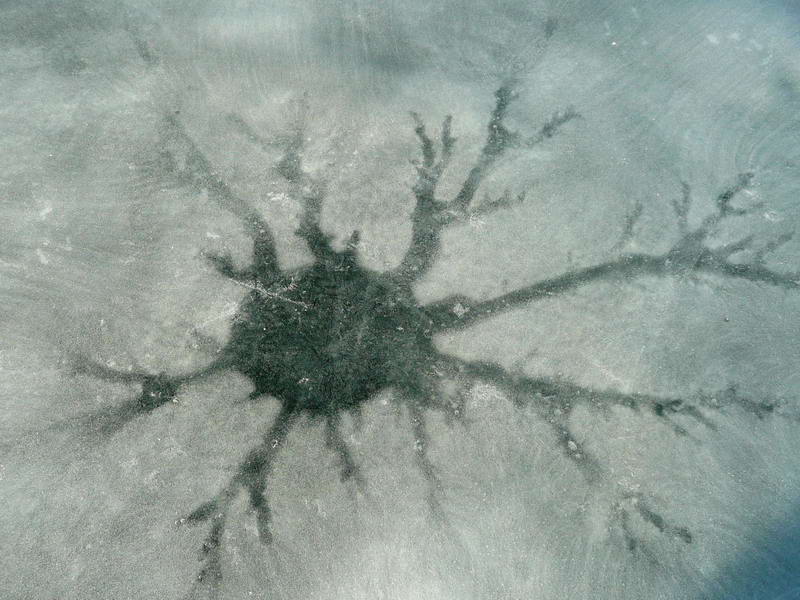 .
.
Stars are found on most ice sheets that are covered with snow ice. Stars range in size from a few inches to a few feet. They are just a small part of a spectacular but infrequently noticed feature that can cover over 5,000 square feet of ice. You can see the faint darcy flow lines formed by the snow and water that flows into the center upflolow hole in the star. For the most part we see stars long after they have frozen solid. In most cases there is enough small interstitial air bubbles (from teh snow) in the snow ice above the dark arms to make details like darcy flow lines hard or impossible to see.
The following is a plausable explanation for lake stars.
Initial ice sheet
- A new black ice sheet forms and thickens to a thickness from 0.5 to 2"
Pore formation
- Pores form in the ice sheet which run vertically. Dissolved salts that get excluded from the solidification process are probably a factor in pore formation. Imperfections in the crystals may be part of the story
- Some ice sheet have lots of little stars and some have relatively few bigger stars..
- Wet cracks form a linear version of a star that does not need pores as the are fed by wet cracks..
Wicking
- Water on the bottom of the ice sheet is at 0 degrees C but is a degree or two warmer a few inches below the the ice sheet. Capillary action wicks water up the the pores where they encounter snow which wicks up the water and forms slush. A simple measurement of 32 deg water wicking from a flat dish showed capillary rise is a couple inches.
Submergence
- The weight of the snow alone or in combination of the snow wicked water exceeds the buoyancy of the ice sheet and pushes it down into the water which causes the water to accumulate enough to submerge the surface of the ice sheet. Once this happens the water flows through the pore to establish hydrostatic equilibrium.
- Drifted snow can be a factor in submergence.
Warm water
- The water feeding the pore starts at 0 degrees but as the water in close proximity is used up the pore starts bringing up deeper, warmer water. The warmer water erodes the pore walls making the pore bigger which has a higher flow rate which brings more water which submerges the ice sheet more quickly
Star formation
- A pore becomes the upflow hole through the ice sheet. It is the source of water for the system. Mature upflow holes are often an inch or more in diameter.
- Over the the upflow hole is a dome that is a few inches in diameter. It appears to form from the momentum of the upflowing water when the it comes through the upflow hole. Or maybe the dome forms from simple melting by the warm water flowing from the upflow hole to the feeder arms
- The density of holes in the ice sheet determines size of the dark arm domain. Sometimes the holes can be just a few inches apart resulting in many smaller stars.
Feeder arms
- The feeder arms are jagged dark arms that radiate from the base of the dome and run across the top of the ice sheet.
- The arms are dark because they erode out most of the slush in their path. Their jaggedness is probably from slow eddy turbulence in the arms. The arms stops growing when the water in them is at 0 degrees and it can't melt anymore slush.
Darcy flow
- Darcy flow is laminar flow through a granular medium. In this case that is a slurry of ice crystals from snow, air bubbles and water....also known as slush. The temperature is 0 degrees so the snow in the slurry does not melt.
- There is a tendency for the bubbles to move to separate from more bubble free areas resulting in the double grey lines of the darcy flow paths. The lighter path is where more air bubbles accumulates. The double paths are about an inch wide and can be several tens of feet in length.
- The darcy paths are guided by the pressure gradient.
Other examples of Darcy flow:
Picture 2
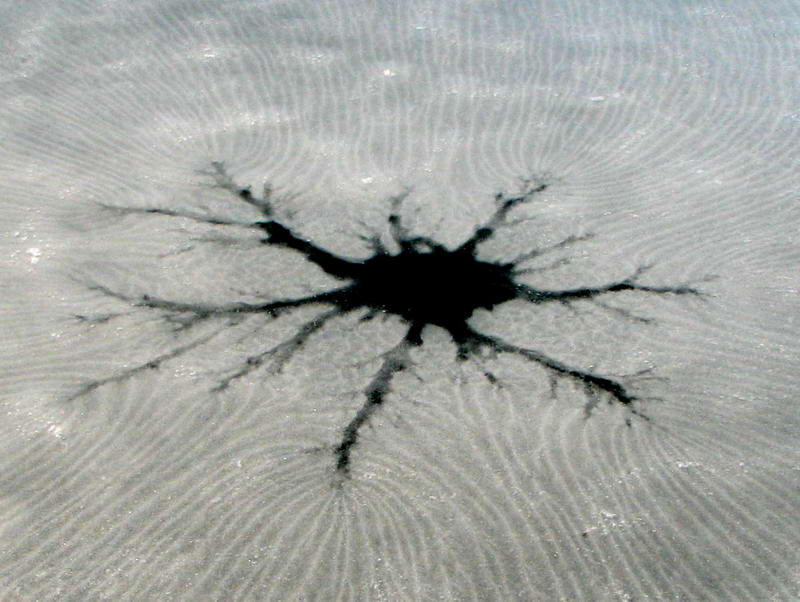
Picture 2 (above) is a frozen star. The upflow hole in the center is about 8" in diameter. It is the source of water from under the ice sheet. The feeder arms transport the water to the darcy flow domain
Picture 2 shows how the flow lines behave if they are not competing with darcy domains from other stars. You can see that, with the exception of the upper right, that the the flow lines exit the picture on a radial path. This is important for the formation of round ice rings.
The streamlines (flowlines) are where the water moved into dry snow to form slush. The water transport force comes mostly from capillary action. The transport paths are nearly flat so gravity is a minor factor .
Pictures 2 and 3 were taken on Lake Champlain off Burlington. The ice showed the patterns with unusually good definition.
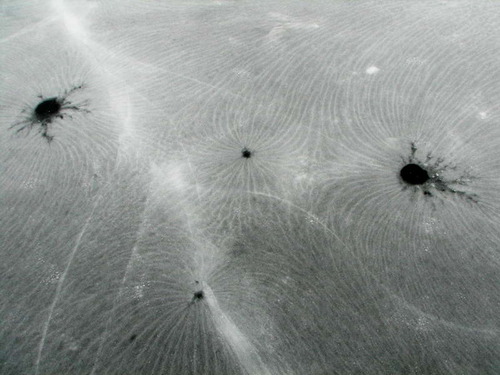
Figure 3 shows how the different water flow paths interact with each other when there are many upflow holes (sources). The flow lines travel from the source to the sink. It The sinks are the advancing slush formation fronts where the transported water encounters dry snow. The ring formation process is blocked by slush from other stars
Stars freeze in cold weather. They can reopen with a subsequent warm spell. I do not know if they act as an upwelling path. We have observed that during thaws with reasonably thin ice that they can open as a drain feature. Figure 3A (below) is an example
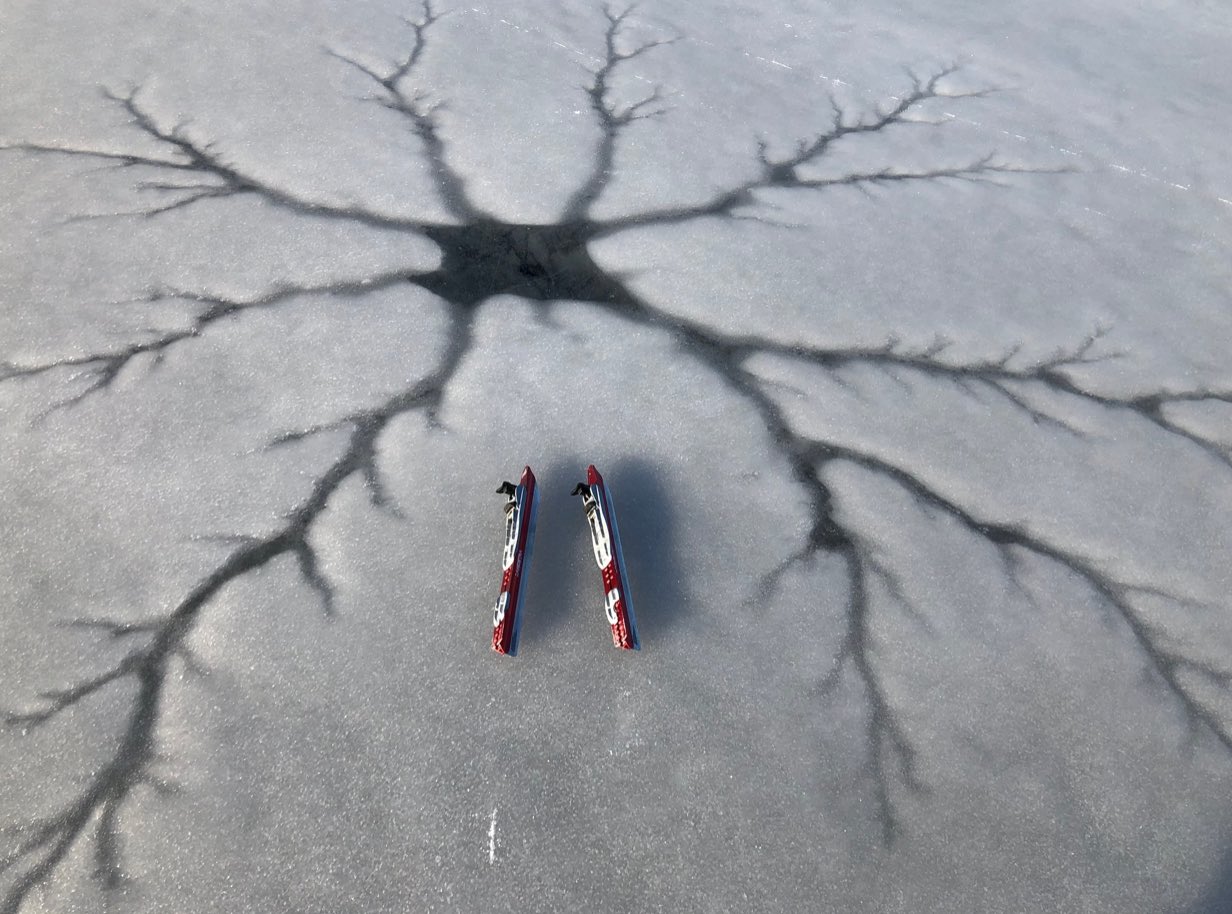
This is a large star in New Hampshire at the tail end of the season. The center hole is open and is acting of a drain hole. It was take by Jamie Hess. His skates are about 0.47 meters long.
************************************************************** )
Opacity:
Snow ice is full of air bubbles that mostly came from the slush formation process. It is common for features of interest to be difficult or impossible to see. The snow ice tends to build up near the surface and the black ice generally develops from the bottom of the ice sheet. Ice generally melts from top and Features of interest may become visible as the surface melts away.
Black ice is generally pretty clear. S1 black ice often is full of melt figures in sunny conditions.Type S2 is dark as the crystal boundary are closer and provides more drain passages to get vacuum bubbles in contact with water in an under the ice. See the melt figures page on this.
The following are a few more pictures of Lake Stars
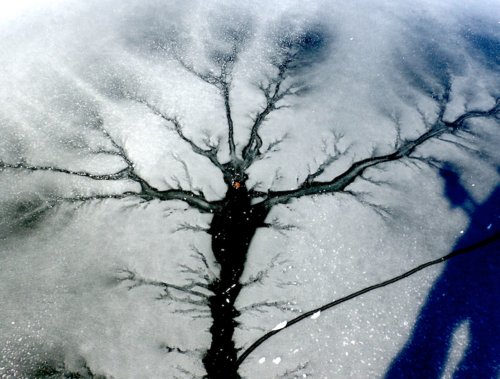 The above is part of the dark feeder arms (black). The light grey areas are slush. The dark arms feed water from the upflow holes or cracks. The small bit of at the center is probably a bit of cedar. The upper part of the picture shows the mixing of dry snow, air bubbles and water. The lighter the color the the more air bubbles. The bubbles are interstitial bubbles in the slush
The above is part of the dark feeder arms (black). The light grey areas are slush. The dark arms feed water from the upflow holes or cracks. The small bit of at the center is probably a bit of cedar. The upper part of the picture shows the mixing of dry snow, air bubbles and water. The lighter the color the the more air bubbles. The bubbles are interstitial bubbles in the slush
Dr Knight tells a story about rice farmers in a town in Northern Japan. If they got stars that looked like palm trees they would expect a good harvest. This image is pretty palm tree like...
The picture is about 5 feet across.
***************************************************************
Below is the same star from modrate change of position
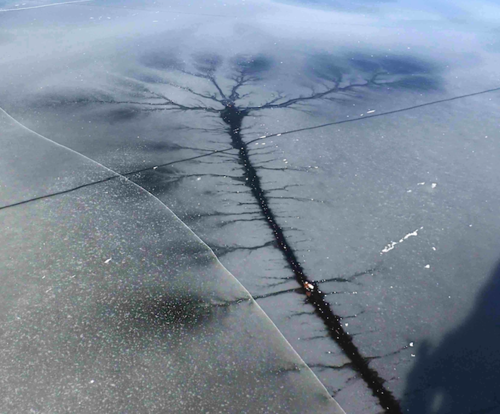
Above: another example of darcy flow paths through slush and dark water flow paths melted into the slush layer. This appears to be a linear star with the initial feeder is a wet crack.
The top part of the picture shows the apparent sink for the flow. The whitish fog may be accumulated air bubbles.
*********************************************************************************.
Below is a frozen circular crack on Shelburne Pond, VT. It may be a ring crack from ring formation that has large spacing between the rings. The reason for the large separation not clear but the circularity is suggests it has some relation to large concentric rings.
In the background is a large, dark new-ice-hole that formed after the snow ice in the forground formed. Typically snow ice forms by when snow falls on an existing black ice layer. It then gets rained on. Drifting before raining can result in a variable thickness of the snow ice layer
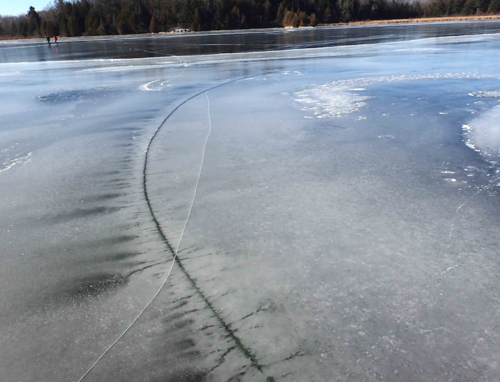
The above picture shows several interesting features. It was taken on Shelburne Pond, VT. The circular black line that It is unusual because the ring to ring distance is quite large (20+ feet?). It may be intervening rings are covered with more snow or that the dark circular ring dominated the water available to flow through the rup rupture or more likely what I have called a linear lake star where
******************************************************************************************
*****************************************************************************************
Large concentric ring structures
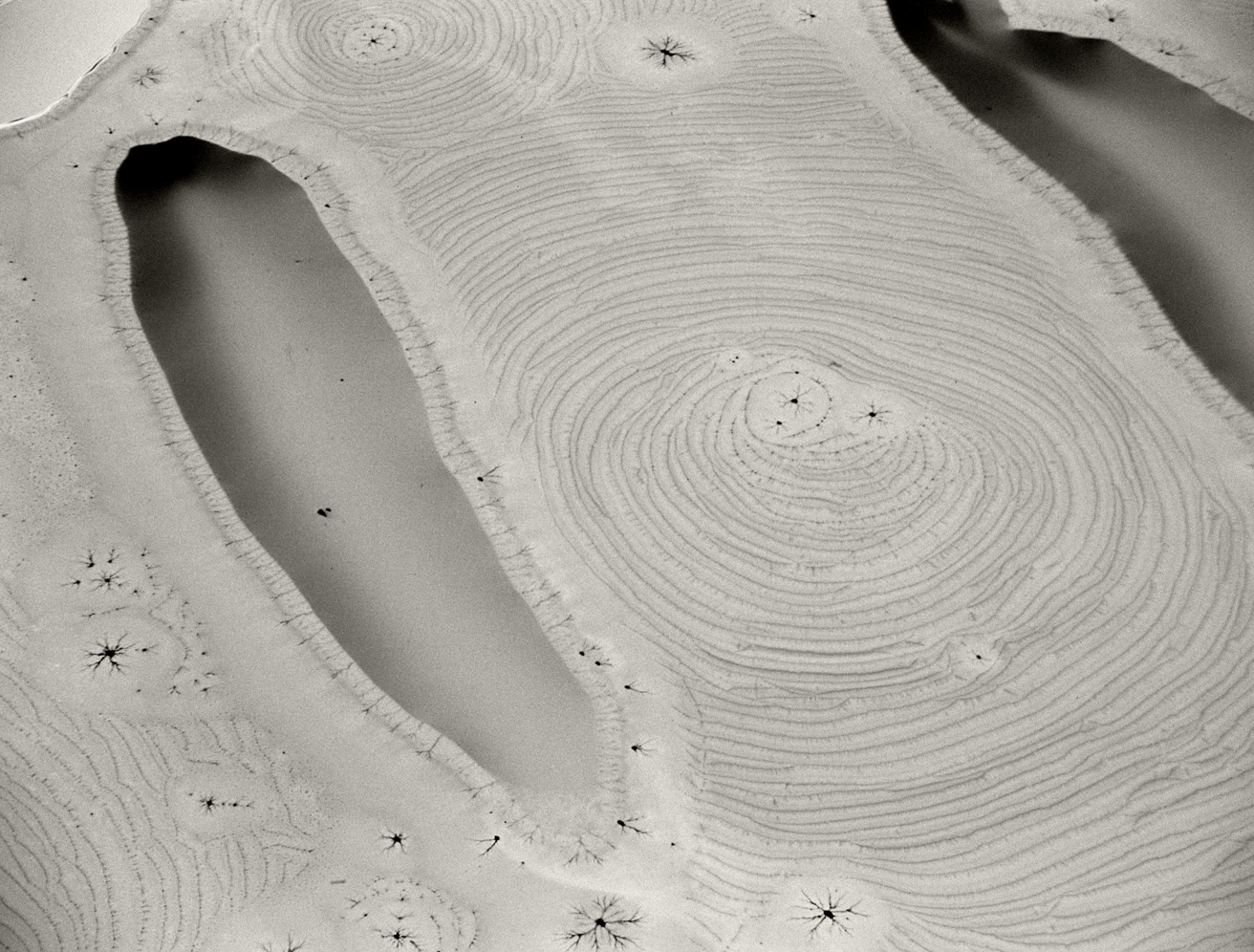
One of the 2002 pictures. Picture from Rick Paridis
the smooth grey is probably ponds with floating slush??
The ponds are ringed by a band white ice with orthagional lake stars and a wider band of light grey white ice. Linear stars form at wet cracks that allow the water to be wicked by dry snow. Wind blows dry snow over the crack to give easy access to the feeder lines and darcy flow domain. They are called linear stars on the lakeice site.
The smooth white is darcy flow. It can be seen around stars (both radial and linear stars).
Stars can be seen at the center of all ring structures. Some times there are two or more stars inside the first ring.
Large scale ring pattern
- In late 2018 we had many very large ring structures on Shelburne Pond in Vermont. The ring structures all began with stars. Beyond the dark arms of the star ring about 20 feet in diameter to the first ring. From there the ring structure continues until it intersects an adjoining ring structure. I counted well over 100 rings one structure. On average the rings are about a foot apart. The spacing of the rings is more like 3 feet at Norway Pond (Hancock NH) this year.
- The rings are pseudo concentric. They split orcombine occasionally. Frequently the rings become partial rings ('arcs') .
- At first, the ring pattern was thought to be a rare occurance. It turned out that when we started looking for them they were pretty common. I guess that they can be found 50% of the winters, looking at a few at a few lakes and ponds. They probably occur most often when the ice is weak. They are best seen from a drone or small airplane. We have seen them on on 40 acre ponds to the middle of the biggest lake in NH.
- Other pages on the Lake Ice web site have more information about lake stars and Ice Rings.
Notes:
Click Here to see internal pictures of an ice star.
1) Ice: The Nature, The History, And The Uses Of An Astonishing Substance Mariana Gosnell, Published by Alfred A. Knopf. Chapter 1. Comment: This is an excellent and broad look at ice.
2) Charles A Knight wrote a paper on Slush on Lakes in 1987 that explains the formation process. See CRREL record ID 51000661 or ask your public library to get you a copy. Comment: In Dr Knight's paper he mentioned that one of the many snow ice formations were large concentric ring patterns that were disussed on this page (above).
3) Star patterns on lake ice: Victor C. Tsai and J. S. Wettlaufer: A technical paper on lake stars
4) Article on lake stars
https://www.gi.alaska.edu/alaska-science-forum/lake-stars-and-windshield-cracks-forming-all-over-alaska
